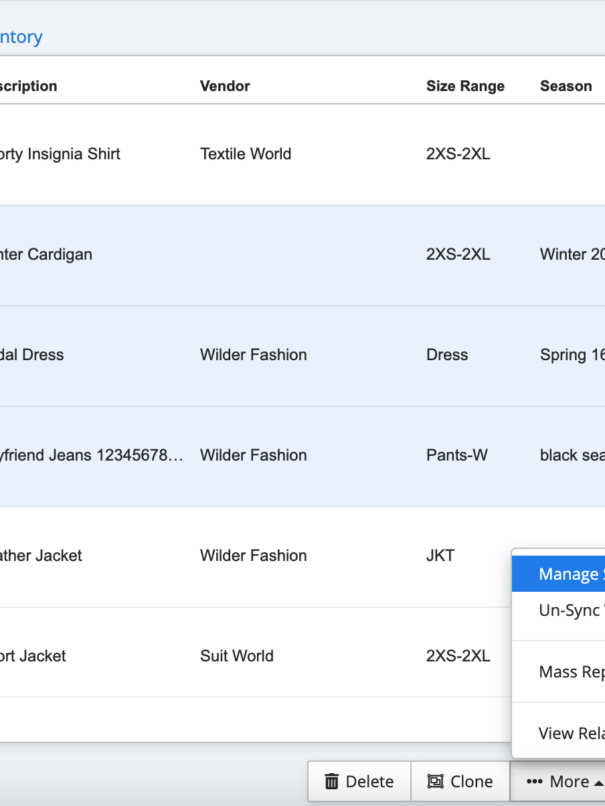2024 is shaping up to be the year when apparel businesses completely embrace the benefits technology solutions bring to the table. At the forefront of these digital results, we of course have enterprise resource planning tools.
As things stand, the ERP industry is set to reach $123.41 billion by 2030. These numbers indicate just how much these tools can help businesses in their day-to-day operations.
In a nutshell, ERP systems are the keys that can clock business efficiency and position your apparel brand as one of the most effective and productive in the industry.
With that in mind, let’s explore the most prominent benefit of ERP software, and discuss some future trends as well as what can make your software selection process much easier.
The Evolution of ERP Software
The apparel industry has transitioned from generic, one-size-fits-all solutions to more customized, industry-specific applications.
Initially, ERP systems were primarily inventory management solutions and had basic accounting, and finance functions. However, as the industry’s complexity increased with global supply chains, fast fashion cycles, and the rise of e-commerce, the need for more specialized ERP solutions became evident.
These specialized systems now offer features such as size and color matrix management, style lifecycle management, and quick response (QR) code integration, which are critical for apparel businesses to efficiently manage their operations.
The Future is Here With Industry-Specific ERP Solutions
We can safely conclude that the future is now as ERP solutions are now industry-specific. For instance, if you take a look at the apparel industry, these ERP systems are designed with a deep understanding of the apparel production lifecycle, from design and prototyping to manufacturing and distribution.
For instance, they include specialized modules for product lifecycle management (PLM), supply chain visibility, and quality control, ensuring that apparel companies can keep pace with market demands while maintaining high standards of quality and compliance.
And of course, they are much more advanced inventory management solutions nowadays. With features such as those we list below, every apparel brand can ensure that their inventories are properly stocked and never ever make a mistake and leave a customer waiting.
- Automated reordering: Systems can automatically generate purchase orders when inventory levels fall below predefined thresholds, ensuring that popular items are always in stock.
- Multi-location management: Offers the ability to manage inventory across various warehouses and retail outlets, including transferring stock between locations to meet demand efficiently.
- Demand forecasting: Utilizes historical sales data to predict future demand for products, providing more accurate inventory management solutions and reducing excess stock.
- Seasonality tracking: Recognizes and adjusts for seasonal trends in apparel, helping companies to anticipate changes in demand and adjust inventory levels accordingly.
- Barcode and RFID scanning: Facilitates efficient inventory operations, from receiving and stocking to picking and shipping, through the use of barcode and RFID technologies.
- Supplier management: Integrates supplier data, including lead times and order minimums, into the inventory management process, enhancing supply chain collaboration and efficiency.
- Return management: Efficiently handles returns and exchanges, updating inventory levels in real-time and managing the restocking or disposal of returned items.
- Real-time inventory tracking: Enables businesses to monitor inventory levels across multiple locations in real time, ensuring accurate stock counts and minimizing the risk of stockouts or overstocking.
- Size and color matrix: Specific to the apparel industry, this feature allows for easy management of items that come in various sizes and colors, streamlining the process of tracking and replenishing inventory.
Driving Sustainability In a Very Difficult Area
We all know the impact the fashion industry has on our planet. Fashion production comprises 10% of total global carbon emissions and with that number in mind, it’s only normal for conscious consumers to look for apparel brands that are dedicated to protecting the only planet we have got.
The best ERP systems are equipped with sustainability metrics that apparel brands can track and determine whether their business operations are negatively impacting the environment.
For example, ERP systems can track the environmental impact of materials used, monitor water and energy consumption during production, and ensure compliance with international labor standards, enabling companies to achieve greater transparency and accountability in their sustainability efforts.
Thanks to how ERP systems are evolving, we can safely conclude that each of their added features is bringing us closer to the future and enables businesses to just operate much better and attract clients who are more conscientious.
Offering Customers More
Modern apparel ERP solutions can help apparel brands realize each customer query without a hitch. The backbone of ERP systems is of course data. They gather data each second your apparel store is active and help you recognize the latest trends in consumer behavior.
With such insights, you can always plan your stock and launch special promotions that will help you boost your sales.
The Future Outlook: Innovation, ERP Trends and Integrations
While we can never predict where future ERP trends will take us, there are a lot of rumors swirling around as to what we can expect in the upcoming years.
- Cloud ERP for scalability and flexibility: Apparel businesses are increasingly adopting cloud-based ERP solutions to enhance scalability and flexibility. This is crucial for managing seasonal trends, fluctuating demand, and global supply chains, ensuring real-time data access and collaboration across different locations and departments.
- AI and IoT for Inventory and Supply Chain Management: Integrating AI and IoT with ERP systems can significantly improve inventory management and supply chain operations in the apparel industry. AI can predict demand and optimize inventory levels, while IoT devices can track products in real time from production to delivery, ensuring efficiency and reducing waste.
- Mobile ERP for on-the-go access: Mobile ERP solutions are particularly beneficial for apparel businesses that operate on multiple fronts, from design and production to retail and e-commerce. Mobile access enables real-time decision-making, inventory management, and customer service, providing flexibility to staff and enhancing customer experiences.
- Predictive analytics for trend forecasting: The use of predictive analytics in ERP systems can help apparel companies forecast fashion trends, manage stock levels, and plan collections. By analyzing sales data and market trends, businesses can make informed decisions on production and marketing strategies, staying ahead in the fast-paced fashion industry.
- Automation and RPA for efficient operations: Automation technologies, including robotic process automation, integrated into ERP systems, can streamline operations such as order processing, inventory management, and customer service in the apparel industry. This not only increases efficiency but also allows staff to focus on creative and strategic tasks. In the future, apparel brands can enjoy accurate inventory management solutions without double-checking their systems every time.
- Enhanced cybersecurity measures: With the increasing amount of sensitive data managed by apparel companies, from customer information to proprietary designs, cybersecurity is a top priority. Modern ERP systems for the apparel industry are equipped with advanced security features to protect against data breaches and ensure compliance with data protection regulations.
And let’s not forget that ERPs can integrate with a variety of tools which only further expand their features. For instance, you can now integrate your apparel ERP system with accounting software which will help you keep track of each sale and also help you organize your finances much better.
Plus as we enter the new age, apparel ERPs are set to become the boosters of every e-commerce store. ERP systems can now seamlessly integrate with these platforms and provide data that can be crucial to optimizing each facet of your online store.
Conclusion
The advancements in ERP systems for the apparel industry mark a pivotal shift towards more tailored and effective solutions. As we progress through 2024, it becomes apparent that adopting these systems is not just an option but a necessity for brands aiming to thrive in a complex and competitive marketplace. These systems bring to the forefront capabilities that allow for more nuanced management of inventory, supply chains, and customer relations, all while maintaining an eye on sustainability.
The future shaped by ERP systems in the apparel industry highlights a path toward enhancing operational efficiency and ethical practices, crucial for meeting modern market challenges. As discussions around ERP evolve, the focus will likely shift toward leveraging these technologies for innovation, sustainability, and customer satisfaction. Central to this evolution is the role of managing inventory, supported by the best inventory management software, to streamline operations.
The anticipation of what’s next in ERP systems underscores the dynamic nature of the apparel industry, emphasizing continuous improvement and adaptation. With ERP systems at the core, incorporating inventory software and management practices is essential for businesses aiming to navigate the complexities of today’s market effectively.







